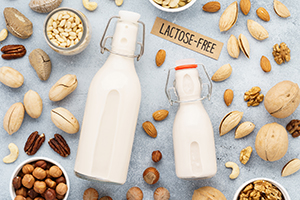Moo-ving On
Explore the Variety of Milk Alternatives
Milk and dairy provide a high source of protein, calcium and other important vitamins and minerals, but they also are the most common allergen for babies and children. Many people also suffer from a lactose (the sugar that is in milk) intolerance. Taking a lactase enzyme or avoiding cow’s milk can help.
If you must avoid milk completely, many grocery stores offer a selection of alternatives to cow’s milk made from rice, nuts, soybeans, coconut, flaxseeds or oats. Flavors may include: original, unsweetened, vanilla or chocolate.
It may take some trial and error to find your preference, but here are some milk options:
- Almond — mildly nutty flavor, lower in calories than cow’s milk, can be swapped easily in baking recipes
- Coconut — rich and creamy, light coconut flavor, high in calories, can be swapped easily in baking recipes
- Cashew — smooth and creamy, lower in calories than cow’s milk, try it in cereal or coffee
- Flax — nutty flavor and creamy, high in Omega-3s
- Macadamia — sweet, nutty flavor and creamy, high in Omega-3s
- Oat — neutral taste, smooth and creamy, try it in your latte or smoothie
- Rice — neutral taste, good alternative to cow’s milk in cooking
- Soy — light nutty flavor, protein content is similar to cow’s milk, unlike the other alternatives
- Walnut — nutty flavor and creamy, high in Omega-3s and higher in protein
Additional things to consider:
- Don’t just look in the diary section. Some grocery stores may have milk alternatives stocked with their health foods.
- Pay attention to packaging and storage. Not all need to be refrigerated prior to opening.
- Be mindful about sugar. Different flavors have variable amounts, which can add up quickly. Learn more about sugar and sugar substitutes.
